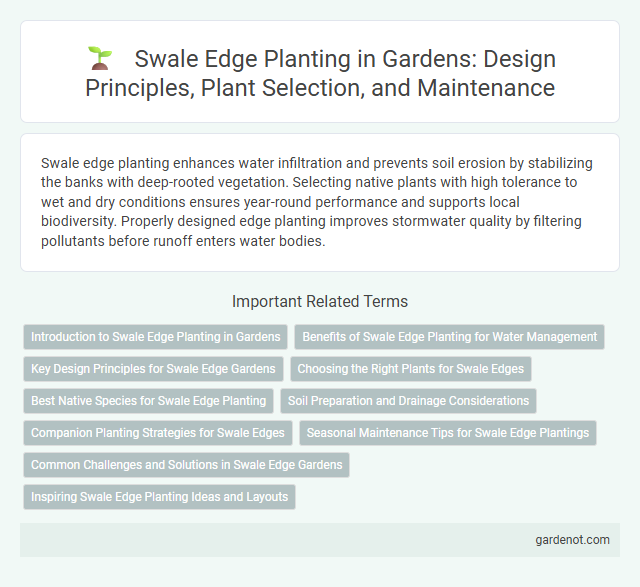Swale edge planting enhances water infiltration and prevents soil erosion by stabilizing the banks with deep-rooted vegetation. Selecting native plants with high tolerance to wet and dry conditions ensures year-round performance and supports local biodiversity. Properly designed edge planting improves stormwater quality by filtering pollutants before runoff enters water bodies.
Introduction to Swale Edge Planting in Gardens
Swale edge planting in gardens enhances water management by stabilizing soil and reducing erosion along the swale's contour. Selecting native grasses, sedges, and moisture-tolerant perennials promotes biodiversity and improves water infiltration efficiency. Strategic placement of these plants creates a natural barrier that filters pollutants while supporting local wildlife habitats.
Benefits of Swale Edge Planting for Water Management
Swale edge planting enhances water management by stabilizing soil and reducing erosion through dense root systems that absorb runoff effectively. Native vegetation along swale edges improves infiltration rates, decreasing surface water flooding and promoting groundwater recharge. These plants filter pollutants from stormwater, leading to improved water quality and ecosystem health in surrounding areas.
Key Design Principles for Swale Edge Gardens
Swale edge planting should prioritize native, deep-rooted vegetation to enhance soil stability and improve water infiltration. Selecting drought-tolerant and flood-resilient plants reduces erosion while supporting local biodiversity. Integrating layered planting strategies with grasses, shrubs, and ground covers creates a functional and aesthetically pleasing buffer that filters runoff effectively.
Choosing the Right Plants for Swale Edges
Selecting appropriate plants for swale edges enhances erosion control and water infiltration, with native species like sedges, rushes, and wildflowers offering deep root systems that stabilize soil effectively. Optimal choices include drought-tolerant varieties such as Carex and Juncus, which thrive in periodic wet and dry conditions typical of swales. Incorporating diverse native grasses and flowering plants supports biodiversity while improving swale functionality and aesthetic appeal.
Best Native Species for Swale Edge Planting
Best native species for swale edge planting include Carex stricta (tussock sedge), Juncus effusus (common rush), and Asclepias incarnata (swamp milkweed), which provide excellent erosion control and habitat benefits. These species thrive in moist, periodically inundated soils typical of swale environments, enhancing water filtration and supporting local biodiversity. Selecting native plants adapted to regional hydrology ensures sustainable swale performance and resilience.
Soil Preparation and Drainage Considerations
Swale edge planting requires careful soil preparation to enhance permeability and support root growth, often involving the incorporation of organic matter and soil amendments to improve texture and nutrient availability. Proper drainage considerations are crucial, ensuring the swale efficiently manages stormwater runoff by preventing waterlogging and promoting infiltration. Selecting native, deep-rooted plants further stabilizes the soil along the swale edge and reduces erosion while maintaining hydrological balance.
Companion Planting Strategies for Swale Edges
Companion planting strategies for swale edges enhance soil stability and water infiltration by selecting species with complementary rooting depths and nutrient requirements. Deep-rooted plants like comfrey interplanted with shallow-rooted species such as clover improve nutrient cycling and reduce erosion along swale margins. Incorporating nitrogen-fixing legumes alongside dynamic accumulators supports soil fertility, fostering resilient swale ecosystems and optimized moisture retention.
Seasonal Maintenance Tips for Swale Edge Plantings
Swale edge planting requires seasonal maintenance to ensure healthy growth and effective water filtration. In spring, remove debris and prune dead foliage to promote new growth, while summer demands consistent watering to prevent drought stress. Autumn maintenance involves cutting back perennials and applying mulch to protect roots during winter dormancy.
Common Challenges and Solutions in Swale Edge Gardens
Swale edge planting often faces challenges such as soil erosion, waterlogging, and invasive weed growth that can hinder plant establishment and growth. Implementing deep-rooted native grasses and perennial sedges helps stabilize soil while improving water infiltration and nutrient uptake. Regular maintenance including mulching and selective weeding promotes healthy vegetation and minimizes competition from invasive species.
Inspiring Swale Edge Planting Ideas and Layouts
Swale edge planting combines functional stormwater management with aesthetic landscaping, using native grasses, sedges, and wildflowers to stabilize soil and enhance biodiversity. Strategic layering of plants like Carex, Juncus, and Echinacea creates vibrant, resilient borders that filter runoff and support pollinators. Innovative layouts integrate curved swale edges with mixed-height vegetation, optimizing water infiltration and visual appeal in urban and rural settings.
Swale edge planting Infographic

 gardenot.com
gardenot.com